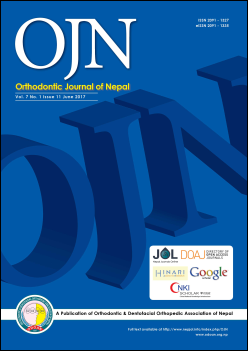Pattern of Third Molar Agenesis among Patients with Different Skeletal Malocclusion
DOI:
https://doi.org/10.3126/ojn.v7i1.18897Keywords:
agenesis, anomalies, skeletal malocclusion, third molarAbstract
Introduction: The third molar tooth is of clinical interest to different specialties of dentistry. It is usually associated with different anomalies for example, malformation, impaction, agenesis etc. This tooth being the last tooth in its molar group; is the most commonly malformed teeth. Third molar agenesis is also associated with other dental anomalies and has significance from evolution point of view.
Objective: To investigate the frequency of third molar agenesis and its relationship with different skeletal malocclusion patterns.
Materials & Method: Pretreatment radiographs of 100 orthodontic patients between 12-17 years of age were collected. Third molar agenesis was calculated and patients’ skeleton malocclusion pattern was determined. Descriptive statistics and chi square test was performed to determine the pattern and potential relation.
Result: Among 100 subjects, 26 were diagnosed with third molar (M3) agenesis, thus the overall prevalence was 26% in the given orthodontic patient sample. The frequency of M3 agenesis was shown to be greater in maxilla (61.5%) than that of mandible (11.5%) (p=0.001). The prevalence of M3 agenesis in subjects with Class I, II and III skeleton malocclusion was 30.3%, 14.3% and 34.4% respectively. Similarly, the order of frequency of M3 agenesis was two (46.2%), one (34.6%), four (11.5%) and three (7.7%) M3’s.
Conclusion: Agenesis of third molar is found to be most common in skeletal Class III malocclusion with the highest prevalence in maxillary arch. Hence proving the inter-relationship between sagittal skeletal malocclusions and third molar agenesis among orthodontic patient sample.
Downloads
Downloads
Published
How to Cite
Issue
Section
License
Copyright © held by Orthodontic & Dentofacial Orthopedic Association of Nepal
- Copyright on any research article is transferred in full to the Orthodontic & Dentofacial Orthopedic Association of Nepal upon publication in the journal. The copyright transfer includes the right to reproduce and distribute the article in any form of reproduction (printing, electronic media or any other form).
- Articles in the Orthodontic Journal of Nepal are Open Access articles published under the Creative Commons CC BY License (https://creativecommons.org/licenses/by/4.0/)
- This license permits use, distribution and reproduction in any medium, provided the original work is properly cited.




